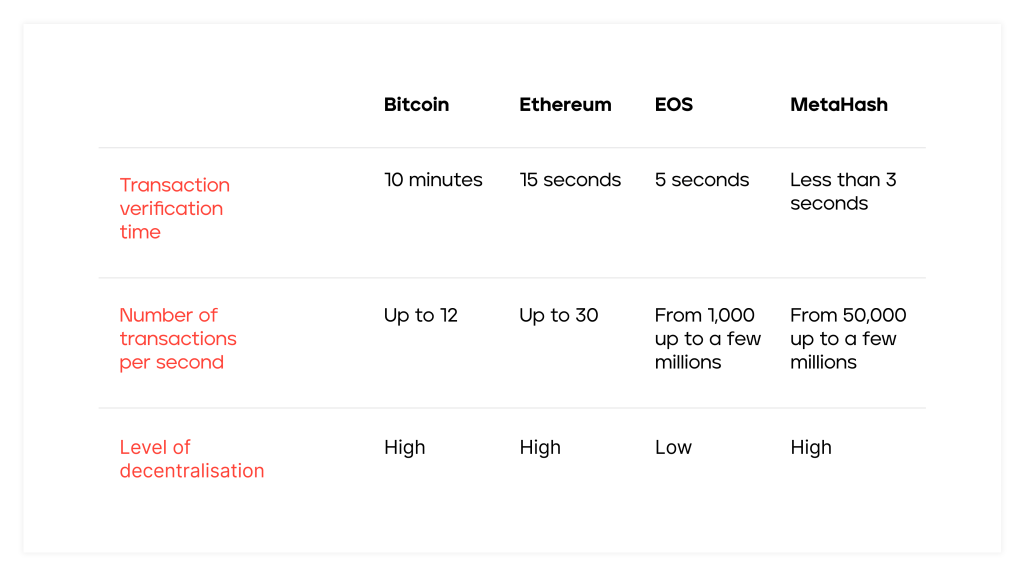Updated May 6, 2022
6 mins
193
What makes the MetaHash blockchain the fastest in the market

In order to assess future perspectives of an asset, you need to understand the technical features of the project. According to CoinGecko, there are more than 13,000 cryptocurrencies today. Some of them run on their own networks such as bitcoin and ether, and some are built on the blockchains of other currencies like tether and USD Coin.
The MetaHash Coin cryptocurrency runs on its own MetaHash blockchain which, as of today, is the fastest in the world. The numbers speak for themselves: it takes 10 minutes to validate a transaction on the Bitcoin network, while MetaHash processes a transaction in just 3 seconds. We will tell you more about how this record speed is achieved and what differentiates MetaHash from other projects.
TraceChain is a unique internet protocol
The MetaHash network is built on the new TraceChain internet protocol. It uses a mathematical model of optimal signal propagation over the network, which allows instant processing of numerous transactions simultaneously. To avoid network overload and slow down from synchronisation of thousands of computers, TraceChain uses mathematical algorithms based on Artificial Intelligence – TraceChain AI. All signals are sent from the outer radius to the cores. They synchronise in multiple powerful cores and then spread across the network.
The more computers you need to synchronise, the higher the network load. This way, MetaHash cores are not static and are constantly altered by voting. To protect the network from attacks, several mechanisms are used at once:
- Added high-performance computers do not automatically become cores.
- Core segments are completely decentralised and protected by Trust algorithms and additional verifications.
- Performance of network core segments is checked and protected by external radiuses.
What are the advantages of TraceChain over other projects
MetaHash has created a network that fulfills all requirements for a new generation blockchain platform:
- Full decentralisation and synchronisation.
- Transaction speed under 3 seconds.
- High network bandwidth.
- Cheap transaction fees due to low commissions.

What gives MetaHash record speed?
MetaHash can process up to 5 billion transactions per day, making the project’s blockchain the fastest in the history of digital currencies. Besides hide speed, it provides many practical benefits:
- The ability to process ALL blockchain transactions in the world.
- Lowest fees in the history of blockchain.
- Competitive price for data storage for third-party decentralised projects.
- Conversion of any Ethereum digital asset of the ERC-20 standard to MHC and vice versa.
- Instant payments in MHC for businesses and private individuals.
How is MetaHash’s reliability ensured?
Each transaction is protected by five different consensus algorithms. This means that even with a billion dollars budget it will be impossible to take control of the network. Additionally, reliability is also ensured by MetaHash’s high decentralisation – the project is run by real people and not by groups of dominant mining pools with giant mining farms.
To protect the MetaHash network from attacks and hacks, the TraceChain AI algorithm blocks a node after an unsuccessful attempt. If a node does not properly process a transaction, its level of trust in the system is set lower. The maximum level is 99% which can only be reached after 6 months of continuous operation. If a node is used to disrupt or slow down the network, it will lose its accumulated “trust” and will not be involved in the validation of transactions for a long period of time.
How is a transaction on the MetaHash network processed?
Stage 1. Transactions are distributed across the network by peer nodes.Stage 2. Transactions begin at the outer radius and then run into the core network using the fastest route.Stage 3. The fastest nodes in the core network verify and synchronise transactions between themselves. Stage 4. The core network returns the balance of the wallets to the blockchain.Stage 5. Blockchain nodes record and store information about all transactions.Stage 6. Every day, the nodes belonging to the MetaHash company establish anchors (a hash from the latest block) for Bitcoin, Ethereum and other networks.
How is the MetaHash network consensus achieved?
The MetaHash network uses the Multi-PoS algorithm, where 67% of the nodes must validate the transaction. The use of multiple consensuses rules out the possibility of gaining control over the network even with a concentration of more than 67% of MHC coins or gaining full control over part of the network. In addition, the PoS multi-consensus considers each member of the network important, and not simply the owners of the largest share of coins.
Conclusions
The MetaHash blockchain is unique in the market since it not only solves the scalability problem that Bitcoin faces, but also makes it possible to process transactions cheaply when compared to Ethereum.
Thanks to five different consensus algorithms, the system is highly reliable, which prevents the network from being hacked even with a billion-dollar budget!
MetaHash can be named the fastest blockchain in the world with the ability to process up to 5 billion transactions per day and validate transactions in less than 3 seconds.
Check out MetaHash’s and the MHC project cryptocurrency’s other benefits and take a step into the future of digital finance.
Register on aStake to receive a stable passive income with cryptocurrency